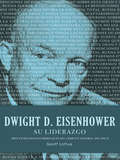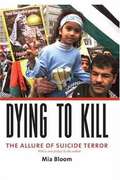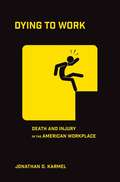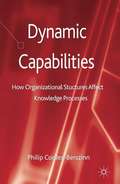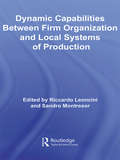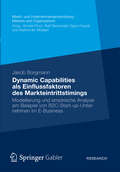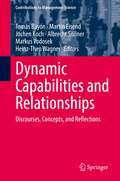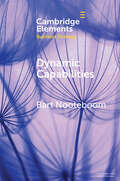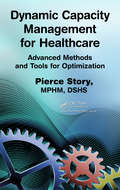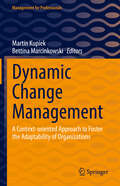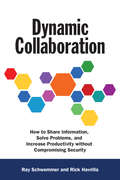- Table View
- List View
Dwight D. Eisenhower su liderazgo
by Geoff LoftusLos métodos de liderazgo de Dwight Eisenhower durante el proyecto más intimidante de la historia, la invasión del Día D, proveen estrategias invaluables para el empresario de hoy.Ningún gerente general moderno ha conducido tal organización --las inmensas Fuerzas Armadas Aliadas de Estados Unidos, Gran Bretaña y Canadá--, ante tanta presión de tener que alcanzar el éxito. Comienza con él presentándose para trabajar como el gerente general del Día D Inc., teniendo que crear a un cuerpo directivo y compañía, y manejando las invasiones de África y Sicilia. Analizando operativos militares como operaciones comerciales y al general en jefe como gerente general. Proporciona lecciones de gerencia tales como:Conducir la junta directiva: FDR, Churchill y los jefes del Estado Mayor ConjuntoCrear la compañía: Convirtiendo a las Fuerzas Armadas Aliadas en una sola fuerza que pudiera cumplir con su misiónComprender la competencia y el mercado: Hitler y la Europa ocupada.
Dwight D. Eisenhower: Changing the World
by Robert L. Simons Shirley SunThis case describes the rise of Dwight (Ike) Eisenhower from a small town in Kansas to the pinnacle of power on the world stage. During his life, Eisenhower was leader of the Allied Forces in World War II, president of Columbia University, head of NATO, and president of the United States for two terms. Students will learn how he navigated life's choices to leave a lasting impact on the world.
Dwight D. Eisenhower: Changing the World
by Robert Simons Shirley SunThis case describes the rise of Dwight (Ike) Eisenhower from a small town in Kansas to the pinnacle of power on the world stage. During his life, Eisenhower was leader of the Allied Forces in World War II, president of Columbia University, head of NATO, and president of the United States for two terms. Students will learn how he navigated life's choices to leave a lasting impact on the world.
Dwyane Wade
by Jennifer Schoppe Anita ElberseIn July 2016, while on his annual China tour to help promote the sportswear brand Li-Ning, basketball superstar Dwyane Wade and his long-time business manager Lisa Joseph-Metelus face a decision regarding one of his other business partnerships-that with the American company Stance, known for its colorful socks. Involved with the young company since 2013, Wade quickly established himself as Stance's most successful brand ambassador. But recently, several younger players had also come on board as endorsers, and Stance had entered into an overall sponsorship deal with the NBA. With his Stance deal coming up for renewal in October 2016, what kind of deal should Wade and Joseph-Metelus propose to Stance? And how would a newly structured partnership fit into Wade's overall business portfolio-including his plans for after his active basketball career?
Dying for a Paycheck: How Modern Management Harms Employee Health and Company Performance -- and What We Can Do About It
by Jeffrey PfefferIn one survey, 61 percent of employees said that workplace stress had made them sick and 7 percent said they had actually been hospitalized. Job stress costs US employers more than $300 billion annually and may cause 120,000 excess deaths each year. In China, 1 million people a year may be dying from overwork. People are literally dying for a paycheck. And it needs to stop.In this timely, provocative book, Jeffrey Pfeffer contends that many modern management commonalities such as long work hours, work-family conflict, and economic insecurity are toxic to employees—hurting engagement, increasing turnover, and destroying people’s physical and emotional health—and also inimical to company performance. He argues that human sustainability should be as important as environmental stewardship. <P><P>You don’t have to do a physically dangerous job to confront a health-destroying, possibly life-threatening, workplace. Just ask the manager in a senior finance role whose immense workload, once handled by several employees, required frequent all-nighters—leading to alcohol and drug addiction. Or the dedicated news media producer whose commitment to getting the story resulted in a sixty-pound weight gain thanks to having no down time to eat properly or exercise. Or the marketing professional prescribed antidepressants a week after joining her employer.In Dying for a Paycheck, Jeffrey Pfeffer marshals a vast trove of evidence and numerous examples from all over the world to expose the infuriating truth about modern work life: even as organizations allow management practices that literally sicken and kill their employees, those policies do not enhance productivity or the bottom line, thereby creating a lose-lose situation.Exploring a range of important topics including layoffs, health insurance, work-family conflict, work hours, job autonomy, and why people remain in toxic environments, Pfeffer offers guidance and practical solutions all of us—employees, employers, and the government—can use to enhance workplace wellbeing. We must wake up to the dangers and enormous costs of today’s workplace, Pfeffer argues. Dying for a Paycheck is a clarion call for a social movement focused on human sustainability. Pfeffer makes clear that the environment we work in is just as important as the one we live in, and with this urgent book, he opens our eyes and shows how we can make our workplaces healthier and better.
Dying of Money: Lessons of the Great German and American Inflations
by Jens O. ParssonThe twentieth century brought the institution of inflation to its ultimate perfection. When economic systems are so highly organized as they became in the twentieth century, so that people are completely dependent on money trading for the necessaries of life, there is no place to take shelter from inflation. Inflations in the twentieth century became like inflations in no other century. The two principal inflations that occurred in advanced industrial nations in the twentieth century will probably prove to have done more to influence the course of history itself than any other inflation. One of these was the German inflation that had its roots in World War I, grew to a giddy height and a precipitous fall in 1923, and contributed to the rise of Adolf Hitler and World War II. The other was the great American inflation that had its roots in World War II, grew in the decade of the 1960's toward an almost equally giddy height, and contributed to results which could not even be imagined at the time this book was written.
Dying to Kill: The Allure of Suicide Terror
by Mia BloomWhat motivates suicide bombers in Iraq and around the world? Can winning the hearts and minds of local populations stop them? Will the phenomenon spread to the United States? These vital questions are at the heart of this important book. Mia Bloom examines the use, strategies, successes, and failures of suicide bombing in Asia, the Middle East, and Europe and assesses the effectiveness of government responses. She argues that in many instances the efforts of Israel, Russia, and the United States in Iraq have failed to deter terrorism and suicide bombings. Bloom also considers how terrorist groups learn from one another, how they respond to counterterror tactics, the financing of terrorism, and the role of suicide attacks against the backdrop of larger ethnic and political conflicts. Dying to Kill begins with a review of the long history of terrorism, from ancient times to modernity, from the Japanese Kamikazes during World War II, to the Palestinian, Tamil, Iraqi, and Chechen terrorists of today. Bloom explores how suicide terror is used to achieve the goals of terrorist groups: to instill public fear, attract international news coverage, gain support for their cause, and create solidarity or competition between disparate terrorist organizations. She contends that it is often social and political motivations rather than inherently religious ones that inspire suicide bombers. In her chapter focusing on the increasing number of women suicide bombers and terrorists, Bloom examines Sri Lanka, where 33 percent of bombers have been women; Turkey, where the PKK used women feigning pregnancy as bombers; and the role of the Black Widows in the Chechen struggle against Moscow. The motives of individuals, whether religious or nationalist, are important but the larger question is, what external factors make it possible for suicide terrorism to flourish? Bloom describes these conditions and develops a theory of why terrorist tactics work in some instances and fail in others.
Dying to Live
by Mizue Aizeki Joseph NevinsPraise for A Not-So-Distant Horror:"[A] remarkable book."--Noam ChomskyTold through the life story of a young man who perished in the California desert, Dying to Live is a compelling account of US immigration/border enforcement and the rapidly growing death toll among migrants. Stunning photos by Mizue Aizeki complement the text.Joseph Nevins authored Operation Gatekeeper: The Rise of the Illegal Alien and the Making of the U.S.-Mexico Boundary (Routledge, 2002), and A Not-So-Distant Horror (Cornell, 2005). His writings have appeared in the Boston Review, The Christian Science Monitor, and the International Herald Tribune.
Dying to Work: Death and Injury in the American Workplace
by Jonathan D. KarmelIn Dying to Work, Jonathan Karmel raises our awareness of unsafe working conditions with accounts of workers who were needlessly injured or killed on the job. Based on heart-wrenching interviews Karmel conducted with injured workers and surviving family members across the country, the stories in this book are introduced in a way that helps place them in a historical and political context and represent a wide survey of the American workplace, including, among others, warehouse workers, grocery store clerks, hotel housekeepers, and river dredgers.Karmel’s examples are portraits of the lives and dreams cut short and reports of the workplace incidents that tragically changed the lives of everyone around them. Dying to Work includes incidents from industries and jobs that we do not commonly associate with injuries and fatalities and highlights the risks faced by workers who are hidden in plain view all around us. While exposing the failure of safety laws that leave millions of workers without compensation and employers without any meaningful incentive to protect their workers, Karmel offers the reader some hope in the form of policy suggestions that may make American workers safer and employers more accountable. This is a book for anyone interested in issues of worker health and safety, and it will also serve as the cornerstone for courses in public policy, community health, labor studies, business ethics, regulation and safety, and occupational and environmental health policy.
Dylan Pierce at Hanguk Industries
by Karthik RamannaHanguk Industries' U.S. country manager, Peter Lee, has a problem - his star hire, Dylan Pierce, is threatening to quit. Hanguk is a large Korean conglomerate multinational that has been keen to attract foreigners. Dylan was hired by Peter to work in Hanguk's U.S. operations. After 18 months, Dylan was promoted to company HQ in Seoul, to work with Peter's former boss. Dylan, who is gay and who thrived at Hanguk's California office, quickly runs afoul of the conservative culture at Hanguk's Korean HQ. Dylan's boss in Korea tells him he needs to be less "girly" if he wants to succeed at the company. Angered, humiliated, and confused, Dylan tells Peter he's ready to quit. Peter must respond.
Dynamic Affirmations: Learn to Live the Law of Attraction with Purpose and Passion
by Jodi SantangeloWhen Affirmations Don’t Work and Success is a Secret. Luck? Hard work? Secret strategies? How do others succeed while you keep struggling to reach your goals? (Even simple affirmations don’t seem to work for you.) What do others know that you don’t? If you believe you deserve to achieve what you want in life--health, good relationships, money, and more--you deserve to know how the attraction effect works to create Dynamic Affirmations. Discover proven methods for reaching your goals. See why other highly hyped solutions haven’t worked for you. Enjoy using 17 easy, effective steps for getting what you want and deserve. Learn how to focus the brain power you already have. Attract the healthy relationships your life and business thrive on. Make the attraction effect work for you and your affirmations so it stops working against you!
Dynamic Analysis in Complex Economic Environments: Essays in Honor of Christophe Deissenberg (Dynamic Modeling and Econometrics in Economics and Finance #26)
by Herbert Dawid Jasmina ArifovicThis book analyses decision-making in dynamic economic environments. By applying a wide range of methodological approaches, combining both analytical and computational methods, the contributors examine various aspects of optimal firm behaviour and relevant policy areas. Topics covered include optimal control, dynamic games, economic decision-making, and applications in finance and economics, as well as policy implications in areas such as pollution regulation. This book is dedicated to Christophe Deissenberg, a well-known and distinguished scholar of economic dynamics and computational economics. It appeals to academics in the areas of optimal control, dynamic games and computational economics as well as to decision-makers working in policy domains such as environmental policy.
Dynamic Approaches to Global Economic Challenges
by Birgit Bednar-Friedl Jörn KleinertThis book addresses three big economic challenges from a dynamic perspective: European integration, economic growth, and global climate change. In the light of the recent crises of the European Union (EU), the first part of the book deals with challenges to the real, monetary and fiscal integration of the EU and required institutional adjustments. The second part of the book addresses fundamental challenges of advanced market economies like economic growth and changes of technologies. The final part focuses on the global challenge of climate change from an economic perspective and discusses policy strategies for a successful mitigation of climate change.
Dynamic Business Law: The Essentials
by Nancy Kubasek Linda Barkacs Lucien Dhooge M. Browne Daniel HerronDynamic Business Law: The Essentials is appropriate for the one-semester Business Law course. It contains the basics of business law but does not get bogged down in the kind of details that are more appropriate in an upper-level law class. The text provides an examination of the basic questions, concepts, and legal rules of business law. Emphasis on the BUSINESS in business law. Dynamic Business Law: The Essentials emphasizes the tie of legal issues back to the core business curriculum. This will help both students and faculty. Faculty need to know how this is integrated as they are constantly 'defending' the inclusion of this course in the business curriculum. And students need to understand how the concepts tie to their future business careers. Emphasis on TEACHING. Many professors teaching this course are attorneys first and academics second. They do not have a lot of time to prepare or think about how to apply this information effectively for their business students. Dynamic Business Law: The Essentials contains a helpful instructor's manual, particularly for the many adjuncts teaching this course. Emphasis on CRITICAL THINKING. Neil Browne, one of the co-authors of this text, has written a successful text on critical thinking. His framework is included in Dynamic Business Law: The Essentials as well - to help students learn how to frame and reframe a question/issue. Critical thinking questions are also included at the end of each case, to tie in this component even further.
Dynamic Business Process Management in the Knowledge Economy: Creating Value from Intellectual Capital (Lecture Notes in Networks and Systems #71)
by Marek SzelągowskiThis book describes modern dynamic business process management (dynamic BPM), which is considerably different from traditional BPM from 20, 10, or even 5 years ago. It demonstrates why traditional BPM is not sufficient in the knowledge economy (KE), while also highlighting the opportunities provided by dynamic BPM – the form of management that practitioners and academics deal with on a daily basis. This involves mastering and implementing e.g. case management, process mining, and RPA, and integrating them with knowledge management. But more importantly, dynamic BPM makes full use of the dynamism of knowledge workers: the people who actually create innovative products and services tailored to the specific needs of clients. The book was primarily written for those managers who see advantageous opportunities amidst the ongoing changes. Accordingly, it focuses more on innovations emerging from practice than on theoretical, academic reflection. In addition to helping organizations operating in the KE to prepare for and implement process management, the book is intended as a source of inspiration for process management researchers and iBPMS system vendors.
Dynamic Capabilities
by Philip Cordes-BerszinnThe concept of dynamic capabilities, especially in terms of organizational knowledge processes, has become the predominant paradigm for the explanation of competitive advantages. However, major unsolved - or at least insufficiently solved - problems are first their measurement and second their management by concrete managerial options, such as design options of organizational structures. Dynamic Capabilities provides an integrated descriptive model of both dynamic capabilities and organizational structures that allows characterizing, classifying and a comparison. It develops a logic system of a multitude of combinatorial possibilities between their variables, and it develops a complex and integrated system of associated empirically based and qualitatively deduced hypotheses. Therewith, it serves as a terminological and analytical foundation for the identification of knowledge-based dynamic capabilities in organizations and for a targeted design of organizational structures that enable and foster dynamic capability processes such as knowledge transfer and knowledge absorption.
Dynamic Capabilities Between Firm Organisation and Local Systems of Production (Routledge Studies In Global Competition Ser.)
by Riccardo Leoncini Sandro MontresorChanges in technology and demand require firms to learn how to continuously reshape unique and non-imitable resources and competences. A firm‘s capacity to achieve this is captured by the concept of dynamic capabilities. This book offers an analysis of how firms manage to reconfigure their pool of idiosyncratic resources, skills and competencies to
Dynamic Capabilities als Einflussfaktoren des Markteintrittstimings
by Jakob BorgmannSeit Jahrzehnten wird sowohl in der betriebswirtschaftlichen Forschung als auch in der Wirtschaftspraxis leidenschaftlich die Frage diskutiert: Sind Pioniere, frühe Folger oder gar späte Folger eines Marktsegments erfolgreicher? Völlig in den Hintergrund geraten ist dabei jedoch die für ein erfolgreiches Markteintrittstiming grundlegende Frage: Welche Faktoren führen überhaupt dazu, dass ein Unternehmen zum Pionier, frühen oder späten Folger wird? Jakob Borgmann identifiziert anhand eines theoretischen Rahmenwerks und plastisch illustrierter Fallstudien die Wirkung einzelner Einflussfaktoren auf das Markteintrittstiming im E-Business.
Dynamic Capabilities and Related Paradigms (Elements in Business Strategy)
by David J. TeeceOf the numerous theories of strategic management, the dynamic capabilities framework is perhaps the most encompassing. Dynamic capabilities are the factors that, if strong, allow an organization to create and deliver value to customers, outcompete rivals, and reap financial rewards over extended periods. The dynamic capabilities framework provides a system-level view of how resources and capabilities are assembled and orchestrated over successive rounds of competition, addressing management's role in determining future requirements and honing the organization's processes and structure to meet them. This Element presents the dynamic capabilities framework and compares it to other paradigms of strategic management and innovation. It demonstrates that these narrower approaches to strategic management and innovation can usefully be thought of as subsets of the dynamic capabilities framework. This will help students and practitioners understand disparate business concepts as part of a unified whole. This title is also available as Open Access on Cambridge Core.
Dynamic Capabilities and Relationships: Discourses, Concepts, and Reflections (Contributions to Management Science)
by Jochen Koch Martin Eisend Tomás Bayón Albrecht Söllner Markus Vodosek Heinz-Theo WagnerBuilding on the seminal work of David Teece, Kathleen Eisenhardt, Jeffrey Martin, and others, this volume applies the concept of dynamic capabilities to help readers understand how organizations can be successful in highly dynamic environments. The contributions, written by researchers who participated in the research program "Dynamic Capabilities and Relationships" and international researchers who participated in the program’s international conference (both funded by the Dieter Schwarz Foundation), highlight state-of-the-art research on dynamic capabilities and relationships. They also put forward an integrated management approach for the purpose of understanding, analyzing, and managing the successful creation and adaptation of capabilities and relationships.
Dynamic Capabilities: Foundational Concepts (Elements in Business Strategy)
by David J. TeeceThe dynamic capabilities framework outlines the means by which the managers of business enterprises foster and exercise organizational and technological capabilities and business strategy to address current and anticipated market and geopolitical conditions. In a firm with strong dynamic capabilities, managers can establish and periodically renew the competitive advantage of the business enterprise by not just responding to but shaping the business environment. This Element relates the dynamic capabilities framework to important concepts from the business and economics literature, demonstrating how it applies to today's business challenges. It also offers a capabilities perspective on a theory of the firm. Most existing theories of the firm caricature today's business enterprise. For advanced students of business, this Element provides a deeper understanding of the dynamic capabilities framework. For managers and boards, it shows how the analytical tools and mindsets that help to make their firms future-ready can be better understood in terms of the dynamic capabilities framework. This Element is also available as Open Access on Cambridge Core.
Dynamic Capabilities: History and an Extension (Elements in Business Strategy)
by Bart NooteboomThe development of salient ideas and publications on dynamic capabilities is given, extended by ideas outside the literature of strategic management. Dynamic capability is presented as an interdisciplinary subject to which knowledge is central. Diversity of knowledge is treated in terms of cognitive distance, limited through organisational focus. To deal with diversity, development and uncertainty, evolutionary theory and the notion of entropy are used. The relation between individual and organisational knowledge is modelled with the notion of a script and linguistic ideas. The governance of collaborative relations for innovation is discussed, including trust, which are also dynamic capabilities.
Dynamic Capacity Management for Healthcare: Advanced Methods and Tools for Optimization
by Pierce StoryWhile hospitals can learn from other industries, they cannot be improved or run like factories. With work that is more individualized than standardized, and limited control over volume and arrivals, even the leanest-minded hospital must recognize that healthcare systems are more dynamic than nearly any work environment.Written with the creativity n
Dynamic Change Management: A Context-oriented Approach to Foster the Adaptability of Organizations (Management for Professionals)
by Martin Kupiek Bettina MarcinkowskiThis book offers a new perspective on change projects in organizations. While traditional approaches of analysis, planning, and implementation can be too slow and unsatisfactory in dynamic environments, this book introduces a context-oriented, dynamic approach that seamlessly integrates technology, processes, and people into the organizational framework. Drawing from organizational theory, it prioritizes both the formal and informal aspects of an organization's structure and culture, and emphasizes the emotional side of change. It provides practical guidance on using emotion concepts to facilitate change in a positive way, and covers key supporting technologies, communication strategies, and human resource considerations. In addition to describing the approach, the book provides helpful tips on selecting the right consultants and embedding change know-how for future initiatives. It is an indispensable resource for anyone leading a change project or looking to improve their organization's ability to adapt. So why settle for a traditional approach when you can achieve meaningful change through a dynamic, context-oriented approach?
Dynamic Collaboration: How to Share Information, Solve Problems, and Increase Productivity without Compromising Security
by Ray Schwemmer Rick HavrillaCollaboration is crucial for any kind of organization that wants to be productive, adaptable, and creative. When people are collaborating, profits increase and things get done. When they're not, your organization loses time and energy. Why, then, do many private enterprises and government agencies struggle to provide collaboration tools their employees will actually use? Dynamic Collaboration offers practical advice to help you answer questions like these: - What tools does your organization need to help facilitate collaboration? - How do you ensure that your personnel will use those tools? - How can you protect your privileged information? - How can you harness the power of Web 2.0 and use it to capture the collective intelligence of your organization? Whether you are a leader in the public or private sector or a technologist, you'll discover ways to help team members solve problems they wouldn't otherwise have solved, get work done quicker than ever before, and feel connected because they are working together toward a common goal. "We are witnessing a transformation of collaboration in real time, and there's no better factual content than what Schwemmer and Havrilla have compiled in this book. Having spent time as a CIO at three different government agencies, I recommend this as required reading for those serious about collaboration." --Barry C. West, Executive Vice President, SE Solutions, Inc., and former CIO, US Department of Commerce
